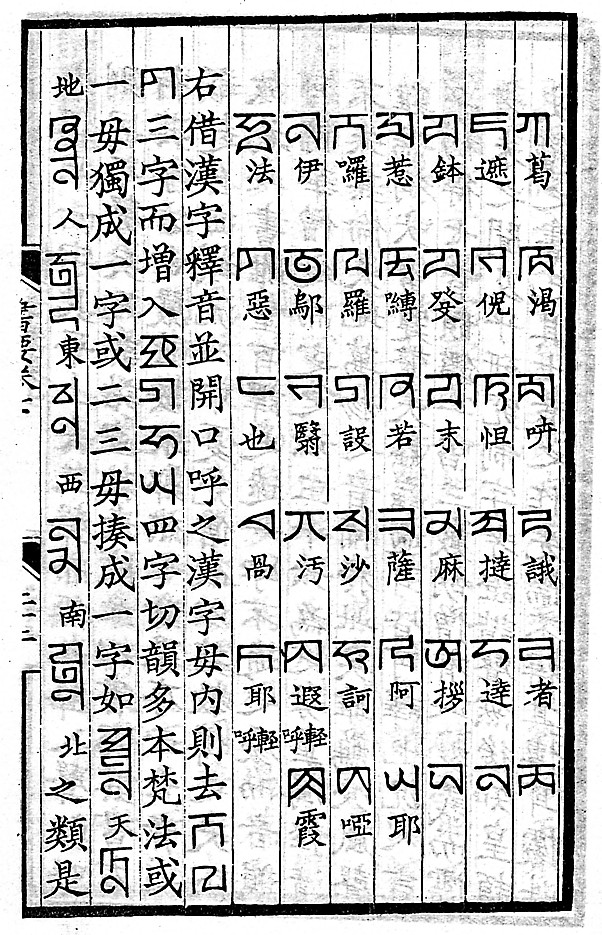
The 'Phags-pa script was created by the Tibetan monk known as 'Phags-pa (1239-1280) at the behest of Kublai Khan between 1260 and 1269. It was intended for use as the "National Script" of the Mongolian Empire, and was used during 13th and 14th centuries for writing Mongolian, Chinese, Uighur, Tibetan and other languages. See my Overview of the 'Phags-pa Script page for further details.
The 'Phags-pa script belongs to the extensive Brahmic family of scripts, which includes Devanagari and most other Indian scripts, as well as many scripts across South-East Asia, and various historical scripts from Central Asia.
The letters of the 'Phags-pa script are derived directly from the Tibetan script, and many of the letters are very similar, or even identical, to their Tibetan counterparts. The correspondences between the letters of the 'Phags-pa script and Tibetan script are shown in Tables 1 and 8.
The 'Phags-pa script is unique amongst Brahmic scripts, in that it is written in vertical columns, from top to bottom, laid out left to right across the writing surface. This follows the format of the Uighur-derived Mongolian script that Kublai Khan intended the new script to replace.
As the script is written from top to bottom, vowel signs (such as the signs for i, e and o) that are placed above the preceding consonant in the Tibetan script, are placed below their preceding consonant in the 'Phags-pa script. This means that, unlike Tibetan, the physical order of the letters represents their logical and pronunciation order (the one exception to this rule is the Candrabindu, which is discussed later on this page).
'Phags-pa letters combine to form discrete syllable units. The letters of a syllable are ligated together, but individual syllables are separated from each other by a narrow space.
For Chinese, which is monosyllabic at the ideographic level, this means that one ideograph corresponds to one 'Phags-pa syllable unit. On the other hand, for languages like Mongolian, Tibetan and Sanskrit, which have polysyllabic words, a word spelled in the 'Phags-pa script comprises one or many ligated syllable units separated by whitespace. Thus the Classical Mongolian word ongɣočas ᠣᠩᠭᠣᠴᠠᠰ "boats" is spelled ong qo chas (three syllables separated by whitespace) in the 'Phags-pa script. Likewise, the Sanskrit word ākaḍḍhaya is spelled '-a kad ddhha ya (four syllables) in the 'Phags-pa script.
The simplest syllable is a single base consonant, which represents the consonant and an inherant a vowel sound. Thus the letter KA by itself forms the syllable ka.
Examples of various 'Phags-pa syllables in Chinese, Mongolian, Tibetan and Sanskrit are given below :
The biography of the 'Phags-pa lama in the History of the Yuan Dynasty (compiled 1369-1370) states that the 'Phags-pa script comprises 41 letters, but unfortunately does not go into any further detail. However there are two contemporary Chinese works that do enumerate these forty-one 'Phags-pa letters :
The descriptions of the 'Phags-pa script given in these two works are translated and discussed in my Forty-One Letters page, and are summarised in Table 1. The order of the letters in the table follows the order given in Fashu Kao and Shushi Huiyao.

Source : Shushi Huiyao 書史會要 vol. 7 folio 22a.
| Number | Letter | Derivation | Letter Name | Transcription | Mongolian Examples | Chinese Examples |
|---|---|---|---|---|---|---|
| 1. | ꡀ | TIBETAN LETTER KA ཀ [U+0F40] | KA | k | Only used for words of foreign origin, such as kal bu dun (gen. pl.) from Sanskrit kalpa "aeon" [cf. Mongolian galab ᠭᠠᠯᠠᠪ], with the single exception of the common Mongolian word ye kee "large, great" [cf. Mongolian yeke ᠶᠡᠬᠡ] | kiw 裘 qiú kue 夔 kuí |
| 2. | ꡁ | TIBETAN LETTER KHA ཁ [U+0F41] | KHA | kh | kheen "who" [cf. Mongolian ken ᠬᠡᠨ] | khang 康 kāng kheeu 屈 qū |
| 3. | ꡂ | TIBETAN LETTER GA ག [U+0F42] | GA | g | bi chig "written document, book" [cf. Mongolian bičig ᠪᠢᠴᠢᠭ] | ging 荊 jīng gu 古 gǔ |
| 4. | ꡃ | TIBETAN LETTER NGA ང [U+0F44] | NGA | ng | deng ri "heaven" [cf. Mongolian tengri ᠲᠡᠩᠷᠢ] | ngiw 牛 niú ngem 嚴 yán ding 丁 dīng |
| 5. | ꡄ | TIBETAN LETTER CA ཅ [U+0F45] | CA | c | cay 柴 chái ci 池 chí | |
| 6. | ꡅ | TIBETAN LETTER CHA ཆ [U+0F46] | CHA | ch | cha q-an "white" [cf. Mongolian čaɣan ᠴᠠᠭᠠᠨ] | chang 昌 chāng cheeu 褚 chǔ |
| 7. | ꡆ | TIBETAN LETTER JA ཇ [U+0F47] | JA | j | jil "year" [cf. Mongolian ǰil ᠵᠢᠯ] | jim 針 zhēn |
| 8. | ꡇ | TIBETAN LETTER NYA ཉ [U+0F49] | NYA | ny | nyiw 鈕 niǔ | |
| 9. | ꡈ | TIBETAN LETTER TA ཏ [U+0F4F] | TA | t | Mostly used in words of foreign origin, such as 'er ti nis (also 'er di nis) "jewels" [cf. Mongolian erdenis ᠡᠷᠳᠡᠨᠢᠰ] and ta layi "sea, ocean" [cf. Mongolian dalai ᠳᠠᠯᠠᠢ] | ten 田 tián tung 童 tóng |
| 10. | ꡉ | TIBETAN LETTER THA ཐ [U+0F50] | THA | th | thu thum "each, all" [cf. Mongolian tutum ᠲᠤᠲᠤᠮ] | thang 湯 tāng thung 通 tōng |
| 11. | ꡊ | TIBETAN LETTER DA ད [U+0F51] | DA | d | u ri da nu (gen.) "former, previous" [cf. Mongolian urida ᠤᠷᠢᠳᠠ] | dung 東 dōng du 都 dū |
| 12. | ꡋ | TIBETAN LETTER NA ན [U+0F53] | NA | n | ma nu "our" [cf. Mongolian manu ᠮᠠᠨᠤ] | nee 聶 niè nung 農 nóng gon 管 guǎn |
| 13. | ꡌ | TIBETAN LETTER PA པ [U+0F54] | PA | p | Only used in words of foreign origin, such as pur xan "Buddha" [cf. Mongolian burqan ᠪᠤᠷᠬᠠᠨ] | pang 龐 páng pay 白 bái |
| 14. | ꡍ | TIBETAN LETTER PHA ཕ [U+0F55] | PHA | ph | phon 潘 pān phu 浦 pǔ | |
| 15. | ꡎ | TIBETAN LETTER BA བ [U+0F56] | BA | b | ba sa "then, still, also" [cf. Mongolian basa ᠪᠠᠰᠠ] | ban 班 bān been 邊 biān |
| 16. | ꡏ | TIBETAN LETTER MA མ [U+0F58] | MA | m | 'a mi than "living beings" [cf. Mongolian amitan ᠠᠮᠢᠲᠠᠨ] | min 閔 mǐn mew 苗 miáo gim 金 jīn |
| 17. | ꡐ | TIBETAN LETTER TSA ཙ [U+0F59] | TSA | ts | tsaw 曹 cáo tsin 秦 qín | |
| 18. | ꡑ | TIBETAN LETTER TSHA ཚ [U+0F5A] | TSHA | tsh | Only used in words of foreign origin, such as sha tshin "religion" | tshay 蔡 cài tshiw 秋 qiū |
| 19. | ꡒ | TIBETAN LETTER DZA ཛ [U+0F5B] | DZA | dz | dzam 昝 zǎn dzew 焦 jiāo | |
| 20. | ꡓ | TIBETAN LETTER WA ཝ [U+0F5D] | WA | w | Only used in words of foreign origin, such as wa chi ra ba ni "Vajrapāṇi" | wan 萬 wàn wu 武 wǔ xiw 侯 hóu gaw 高 gāo |
| 21. | ꡔ | TIBETAN LETTER ZHA ཞ [U+0F5E] | ZHA | zh | zheeu 茹 rú zhew 饒 ráo | |
| 22. | ꡕ | TIBETAN LETTER ZA ཟ [U+0F5F] | ZA | z | Only found in the single word za ra "month" [cf. Mongolian sara ᠰᠠᠷᠠ] | zeeu 徐 xú zi 席 xí |
| 23. | ꡖ | TIBETAN LETTER -A འ [U+0F60] | -A | - | This letter is found rarely initially, e.g. -ir gee nee (dat./loc.) "people" [cf. Mongolian irgen ᠢᠷᠭᠡᠨ], but frequently medially between vowels where it serves to separate a syllable that starts with a vowel from a preceding syllable that ends in a vowel, e.g. er khee -ud "Christians" and q-an "emperor, khan" [cf. Mongolian qaɣan ᠬᠠᠭᠠᠨ] (where q-an is a contraction for the hypothetical qa -an) | -an 安 ān -ing 應 yīng -eeu 郁 yù |
| 24. | ꡗ | TIBETAN LETTER YA ཡ [U+0F61] | YA | y | na yan "eighty" [cf. Mongolian nayan ᠨᠠᠶᠠᠨ] | yi 伊 yī yang 羊 yáng day 戴 dài hyay 解 xiè |
| 25. | ꡘ | TIBETAN LETTER RA ར [U+0F62] | RA | r | chee rig "army" [cf. Mongolian čerig ᠴᠡᠷᠢᠭ] | |
| 26. | ꡙ | TIBETAN LETTER LA ལ [U+0F63] | LA | l | al ba "tax, tribute" [cf. Mongolian alba ᠠᠯᠪᠠ] | leeu 呂 lǚ lim 林 lín |
| 27. | ꡚ | TIBETAN LETTER SHA ཤ [U+0F64] | SHA | sh | shi nee "new" [cf. Mongolian šine ᠱᠢᠨᠡ] | shi 石 shí shwang 雙 shuāng |
| 28. | ꡛ | TIBETAN LETTER SA ས [U+0F66] | SA | s | hee chus "end, goal" [cf. Mongolian ečüs ᠡᠴᠦᠰ] | su 蘇 sū syang 相 xiàng |
| 29. | ꡜ | TIBETAN LETTER HA ཧ [U+0F67] | HA | h | Initially in words that now have null initials, such as har ban "ten" [cf. Mongolian arban ᠠᠷᠪᠠᠨ], and medially only in the single word -i hee -een (or -i h-een) "protector, guardian" | hwa 花 huā sh.hi 史 shǐ l.hing 冷 lěng j.hang 莊 zhuāng |
| 30. | ꡝ | TIBETAN LETTER A ཨ [U+0F68] | 'A | ' | 'eeu lu "not" [cf. Mongolian ülü ᠦᠯᠦ] | 'wang 王 wáng 'eeu 虞 yú |
| 31. | ꡞ | TIBETAN VOWEL SIGN I ི [U+0F72] | I | i | -i hee -een (or -i h-een) "protection" | li 李 lǐ n.hing 能 néng heei 奚 xī |
| 32. | ꡟ | TIBETAN VOWEL SIGN U ུ [U+0F74] | U | u | u su nu (gen.) "water" [cf. Mongolian usun ᠤᠰᠤᠨ] | u 吳 wú mue 梅 méi |
| 33. | ꡠ | TIBETAN VOWEL SIGN E ེ [U+0F7A] | E | e | e du -ee "now" [cf. Mongolian edüge ᠡᠳᠦᠭᠡ] | ze 謝 xiè jem 詹 zhān gue 國 guó |
| 34. | ꡡ | TIBETAN VOWEL SIGN O ོ [U+0F7C] | O | o | ong qo chas "boats" [cf. Mongolian ongɣočas ᠣᠩᠭᠣᠴᠠᠰ] | no 那 nā mon 滿 mǎn |
| 35. | ꡢ | TIBETAN LETTER KHA ཁ [U+0F41] | QA | q | qa muq "all" [cf. Mongolian qamuɣ ᠬᠠᠮᠤᠭ] | |
| 36. | ꡣ | TIBETAN LETTER KHA [U+0F41] plus TIBETAN SUBJOINED LETTER WA [U+0FAD] ཁྭ | XA | x | Only used in words of foreign origin, such as pur xan "Buddha" [cf. Mongolian burqan ᠪᠤᠷᠬᠠᠨ] | xu 胡 hú xong 黃 huáng |
| 37. | ꡤ | TIBETAN LETTER HA [U+0F67] plus TIBETAN SUBJOINED LETTER WA [U+0FAD] ཧྭ | FA | f | fang 方 fāng fi 費 fèi | |
| 38. | ꡥ | TIBETAN LETTER GA ག [U+0F42] | GGA | |||
| 39. | ꡦ | TIBETAN VOWEL SIGN EE ཻ [U+0F7B] | EE | ee | el deeb "various" [cf. Mongolian eldeb ᠡᠯᠳᠡᠪ] (Poppe reads this word as eel deeb, as the only example of an initial letter EE, but I think that it is clear from the rubbing of the inscription that the initial letter is a slightly deformeed letter E) | chee 車 chē seeu 胥 xū geeing 經 jīng |
| 40. | ꡧ | TIBETAN SUBJOINED LETTER WA ྭ [U+0FAD] | SUBJOINED WA | w | xway 懷 huái jwaw 卓 zhuō gwang 廣 guǎng | |
| 41. | ꡨ | TIBETAN SUBJOINED LETTER YA ྱ [U+0FB1] | SUBJOINED YA | y | hya 夏 xià gya 家 jiā dzyang 蔣 jiǎng |
The forty-one letters given in Fashu Kao and Shushi Huiyao can be classified as consonants, vowels and semi-vowels.
Letters 1-30 and 35-38 are base consonants. The order of Letters 1-30 is the same as the traditional order of the thirty basic letters of the Tibetan script, to which they correspond. Letters 35-38 represent sounds that do not occur in Tibetan, and are either derived from an existing Tibetan base consonant (e.g. Letters 2 and 35 are both derived from the simple Tibetan letter KHA, but are graphically distinct from each other) or from a combination of an existing Tibetan base consonant and the semi-vowel (subjoined) letter WA (e.g. Letter 36 is derived from the complex Tibetan letter KHWA).
As is the case with Tibetan, these letters have an inherant [a] vowel sound attached to them in non-final positions when no other vowel sign is present (e.g. the letter KA with no attached vowel represents the syllable ka, but with an appended vowel i represents the syllable ki).
Letters 31-34 and 39 are vowels. Letters 31-34 follow the traditional order of the corresponding Tibetan vowels. Letter 39 represents a vowel quality that does not occur in Tibetan, and may be derived from the Tibetan double-E vowel sign.
Unlike Tibetan, in which vowels signs may not occur in isolation but must always be attached to a base consonant to form a valid syllable, in the 'Phags-pa script initial vowels other than a may occur without a base consonant when they are not the first element in a diphthong (e.g. ue) or a digraph (e.g. eeu and eeo). Thus in Chinese 'Phags-pa texts the syllables u 吾 wú, on 刓 wán and o 訛 é occur, and in Mongolian 'Phags-pa texts the words ong qo chas "boats", u su nu (gen.) "water", e du -ee "now" and i hee -een "protection" occur. These are all examples of where 'o, 'u, 'e, 'i etc. would be expected if the Tibetan model had been followed exactly. An exception to this rule is the Mongolian word 'er di nis "jewels", where a single vowel sign is attached to a null base consonant. Note that the letter EE is never found in an initial position in any language written in the 'Phags-pa script (for example, in Tao Zongyi's description of the Old Uighur script, he glosses all instances of Uighur e with the 'Phags-pa letter EE, except for when it is found in the initial position, when he glosses it with the 'Phags-pa letter E instead).
However, initial semi-vowels, diphthongs and digraphs must be attached to the null base consonant 'A (Letter 30). So in Chinese 'Phags-pa texts the syllables 'wen 元 yuán, 'ue 危 wēi and 'eeu 魚 yú occur; and in Mongolian 'Phags-pa texts the words 'eeu lu "not" and 'eeog bee.e "gave" occur. As there is no sign for the vowel a, which is implicit in an initial base consonant with no attached vowel sign, then words that start with an a vowel must also use the null base consonant letter 'A (e.g. Mongolian 'a mi than "living beings"). In Chinese, and rarely Mongolian, another null base consonant -A (Letter 23) may be found before initial vowels (see "Letter 23" below).
Letters 40-41 are semi-vowels corresponding to Letters 24 and 20 respectively, and can only be attached to a preceding base consonant. They are used in Chinese and Tibetan, but not in Mongolian (except where transliterating Chinese proper names).
The letters I, U, E and O have a number of presentation forms depending upon their position within a syllable, or whether they represent an isolated syllable in themselves, as shown in Table 2 below.
Note that the letter EE is never found initially (as part of the digraphs eeu and eeo used to represent the front vowels ü and ö it is attached to the null base consonant letter 'A), and keeps the same form medially and finally.
| Vowel | Isolate | Initial | Medial | Final |
|---|---|---|---|---|
| I | ꡞ | ꡞ | ꡞ | ꡞ |
| U | ꡟ | ꡟ | ꡟ | ꡟ |
| E | ꡠ | ꡠ | ꡠ | ꡠ |
| O | ꡡ | ꡡ | ꡡ | ꡡ |
Inexplicably, given that the Tibetan letters from which they are derived are distinct, the Letter 14 (PHA) and Letter 15 (BA) are very similar, and indistinguishable in many texts. Even in texts where they are distinguished the shape of the letter PHA is not always the same.
Letter 20 (WA) probably represents a sound closer to [v] than [w] when it occurs initially. In Mongolian it is used only transliterate Chinese or Sanskrit words (e.g. wa chi ra ba ni for Sanskrit "vajrapāṇi"). In Chinese it is used initially in words that were pronounced [mǐu-] or [mǐw-] in Ancient Chinese (e.g. wun 文 wén from *mǐuən). On the other hand Chinese words that were pronounced [ŋǐw-] or [jǐw-] in Ancient Chinese are spelled with the semi-vowel W (Letter 40) attached to the null base consonant 'A (Letter 30) in the 'Phags-pa script (e.g. 'wen 元 yuán from *ŋǐwɐn and 'waŋ 王 wáng from *jǐwaŋ). It seems reasonable to assume that initial 'Phags-pa w represents a [v] sound, as is the case in some modern Mandarin dialects, whereas initial 'Phags-pa 'w represents a [w] sound.
Compare the difference between Letters 20 and 40 with Letters 24 (YA) and 41 (Y), which both represent the same [j] sound. Initial [j] is spelled as y- in the 'Phags-pa script (e.g. yang 羊 yáng), and the spelling 'y- corresponding to 'w- does not occur as it would represent the same sound as y-.
Letters 20 (WA) and 24 (YA) are used to form diphthongs when they occur in a final position, in much the same way that the letters "w" and "y" are used to form diphthongs in English (e.g. "saw" and "say").
In Chinese the following diphthongs are formed with these two letters :
In Mongolian the letters YA and WA do not form diphtongs like this, but the letter YA followed by the letter I does form a diphthong with a preceding vowel :
In Mongolian the letter -A is used as a null consonant to support a vowel. In this respect it is similar to the letter 'A (letter 30), but whereas 'A is used exclusively to support an initial vowel in the first syllable of a word, the letter -A is rarely used in the initial syllable, and is usually found supporting a medial vowel following a preceding open syllable. The following are the only examples of Mongolian words with initial -A :
It is not clear what the difference between initial -A in these words and initial 'A in other words is.
The normal use of the letter -A is medially in words with a syllable ending with a vowel that is followed by a syllable staring with a vowel, as in these examples :
Sometimes the letter -A is used medially within a syllable, between a base consonant and a vowel, where it appears to be a contraction (or spelling convention) for two adjacent syllables that end and start with the same vowel. Indeed some words are found spelled with the letter -A either between two vowels or between a base consonant and a vowel. The following examples of words with the letter -A between a base consonant and a vowel :
The letter -A is used in Tibetan between a base consonant and a vowel to indicate a long vowel, and it is possible that it serves a similar function in these examples. That is to say, the word q-an may be a contraction of qa -an precisely because the word qa -an (Classical Mongolian qaɣan ᠬᠠᠭᠠᠨ) was pronounced as a single long syllable during the Yuan dynasty rather than two syllables as it would have been in Early Mongolian.
In Chinese the letter -A is used for words that derive from Ancient Chinese [∅-] (null initial). This is in contrast to the letter 'A, which is used for words that derive from Ancient Chinese [ŋ-] (or occasionally [j-]) that was no longer sounded in Yuan Chinese. For example :
In transliterating Sanskrit or writing Tibetan, the letter -A is used to represent a long vowel in a similar way that a subfixed Tibetan letter -A is used to represent a long vowel. However, there is one slight difference in the positioning of the letter -A in 'Phags-pa compared with Tibetan, which is that in 'Phags-pa the vowel-lengthening letter -A precedes a subfixed letter R (but not subfixed letters Y and W), where in Tibetan the subfixed letter -A comes after any other subfixed letters. Thus, for example, Sanskrit bhrūṁ is written as bhr-uM in Tibetan, but as bh-ru^ in the 'Phags-pa script (see Illustration 3 Line 2).
Letter 30 ('A) is a null consonant that acts as base consonant for certain initial vowels.
In Mongolian the letter 'A is used as a null consonant to carry an initial vowel a, a digraph eeo [ö] or eeu [ü], or in one text only an initial vowel e :
In Chinese the letter 'A is used for words that derive from Ancient Chinese [ŋ-] (or occasionally [j-]) that was no longer sounded in Yuan Chinese. This is in contrast to the letter -A, which is used for words that derive from Ancient Chinese [∅-]. For example :
The 'Phags-pa script has two letters for an "e"-like vowel (see Junast 1988 for a discussion of the two 'Phags-pa letters).
Letter 33 (E) is derived from the Tibetan Vowel Sign E, and is used to represent this letter or the corresponding Sanskrit vowel in Buddhist 'Phags-pa texts (see Illustrations 3 and 4 below for examples). It is also used in both Chinese and Mongolian.
Letter 39 (EE) is not used in Tibetan 'Phags-pa texts, but is used in both Chinese and Mongolian.
In Mongolian the letter ee is the normal variety of the "e" vowel in medial and final positions (e.g. dee lee mee "vain, idle"); whereas the letter e only occurs initially (e.g. e du -ee "now"), medially in the first syllable of a word (e.g. the ri -un "first"), or finally as a diphthong element (e.g. bi chi bee.e "[he] wrote"). The letter ee is also prefixed to the vowels u and o to represent the Mongolian vowels ü and ö respectively (e.g. 'eeu deeur chin "all day" for üdürchin, and 'eeog bee.e "gave" for ögbee.e).
In Chinese the letters ee and e represent two different vowel qualities. The two letters are mostly exclusive (e.g. ze 謝 xiè [but no zee] and see 薛 xuē [but no se]), but may occur with the same initial in some cases (e.g. gem 檢 jiǎn and geem 兼 qiān). As with Mongolian, the letter ee may be used in combination with the vowels u and o to represent their front vowel counterparts ü and ö (e.g. seeun 荀 xún and geeon 卷 juǎn). Also as is the case with Mongolian, the letter e may occur finally as an element in a diphthong (e.g. gue 國 guó and geeue 規 kuī).
Letter 37 (FA) is derived from the Tibetan letter HA with a subjoined letter WA, which makes it graphically very similar to the combination of Letters 29 (HA) and 40 (W) that is used to represent the Chinese sound [hw], as in the syllable hwa 花 huā. Some authorities believe that there is no distinction between the glyphs used for f and hw, and accordingly transcribe Chinese syllables written with Letter 37 as if it were a sequence of letters 29 and 40 (e.g. transcribe fung 馮 féng as hwung. This means that syllables such as fa 法 fǎ and hwa 花 huā would be indistinguishable.
I believe that Letter 37 should be considered to be a distinct letter, transcribed differently from the combination of letters 29 and 40, for two reasons.
Firstly, the only contemporary sources giving details about the 'Phags-pa script (Fashu Kao, Shushi Huiyao and Menggu Ziyun) treat the letter FA as a distinct letter, and so the original user community can be assumed to have viewed it as a separate logical character.
Secondly, although not all texts differentiate f and hw graphically, they are clearly distinguished in some texts. For example in Baijaxing Mengguwen 百家姓蒙古文 (The Hundred Chinese Surnames in 'Phags-pa Script), the letter FA is written with the WA-hook joined seemlessly onto the main body of the letter (see Table 3), whereas with the combination hw, there is a kink in the tail of the letter HA in four out of five cases (see Table 4), which is not found in any of the examples of the letter FA.
| Example Words | 'Phags-pa Transcription | Corresponding Chinese Ideograph | |
|---|---|---|---|
| 1340 ed. | 1699 ed. | ||
 |  | fam | 范 fàn |
 |  | fan | 樊 fán |
 |  | fang | 方 fāng |
 |  | fang | 房 fáng |
| Example Words | 'Phags-pa Transcription | Corresponding Chinese Ideograph | |
|---|---|---|---|
| 1340 ed. | 1699 ed. | ||
 |  | hwa | 花 huā |
 | hwa | 華 huā | |
 |  | hwaw | 霍 huò |
Letter 38 (GGA), which resembles a Tibetan letter GA, is listed in both Fashu Kao and Shushi Huiyao, but is not found in any extant 'Phags-pa texts or inscriptions, other than the list of seal script forms of 'Phags-pa letters given in Menggu Ziyun 蒙古字韻. This letter is grouped together with the three letters QA, XA and FA that supplement the thirty Tibetan consonants, and so presumably also represents a sound not represented by the original thirty Tibetan letters. It is my belief that this letter represents a glotal stop for use in writing Persian (i.e. the letter 'ayn ع). As no Persian 'Phags-pa texts still exist, to my knowledge, this would explain why this letter has not yet been found in use outside of descriptions of the script.
One of the most important sources for the 'Phags-pa script is the rhyming dictionary of Chinese, Menggu Ziyun 蒙古字韻, the only extant edition of which was revised and edited by Zhu Zongwen 朱宗文 in 1308. This work provides 'Phags-pa spelling for over 9,000 Chinese ideographs, ordered into some 813+ 'Phags-pa syllables. A peculiarity of Menggu Ziyun is that the initial letter of each 'Phags-pa syllable is correlated with one of the Thirty-Six Initials of traditional Chinese phonetics, as shown in Illustration 2.
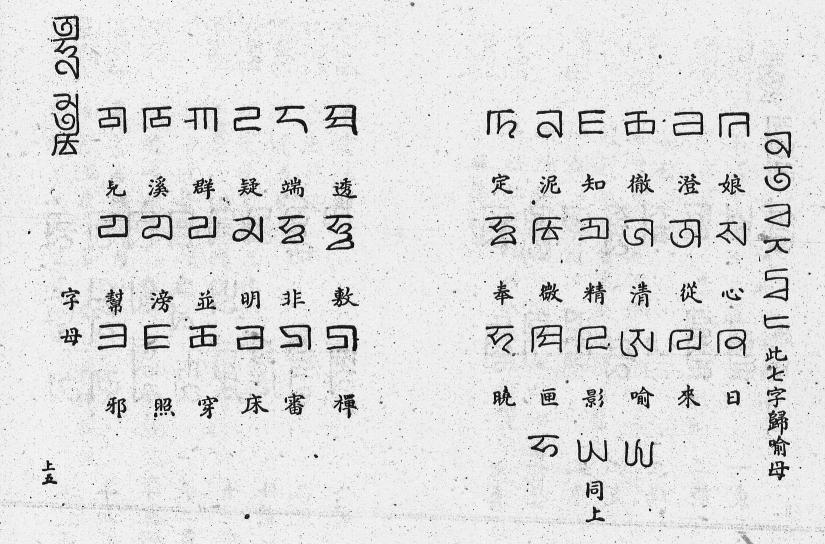
Source : Basibazi yu Yuandai Hanyu 八思巴字與元代漢語 page 97.
As the 'Phags-pa letters represent the pronunciation of standard Chinese (Old Mandarin) during the Yuan dynasty (1271-1368), but the Thirty-Six Initials are an idealised representation of Chinese spoken several hundred years earlier during the Tang (618-907) and Song (960-1279) dynasties, there is degree of mutual incompatability between the two systems of phonetics :
In order to artificially preserve the historical phonetic system represented by the Thirty-Six Initials, Menggu Ziyun uses graphic variants of the letters YA, SHA, HA and FA to distinguish initials that, although pronounced identically in Yuan Chinese, actually derive from different Tang/Song initials, as shown in Table 5.
| Letter | Graphic Form | Transcription | Corresponding Initial | Historical Phonetic Value | Example |
|---|---|---|---|---|---|
| FA 1st Form | ꡤ | f′ | Initial 17 | [pǐw] or [pǐu] | f′un 分 fēn [*pǐuən] |
| FA 2nd Form | ꡰ | f″ | Initial 18 | [p'ǐw] or [p'ǐu] | f″an 翻 fān [*p'ǐwɐn] |
| FA 3rd Form | ꡤ | f‴ | Initial 19 | [bǐw] or [bǐu] | f‴un 汾 fén [*bǐuən] |
| SHA 1st Form | ꡮ | sh′ | Initial 29 | [ɕ] or [ʃ] | sh′i 絁 shī [*ɕǐe] |
| SHA 2nd Form | ꡚ | sh″ | Initial 30 | [ʑ] | sh″i 時 shí [*ʑǐə] |
| HA 1st Form | ꡯ | h′ | Initial 31 | [x] | h′wee 血 xuè [*xiwet] |
| HA 2nd Form | ꡗ | h″ | Initial 32 | [ɣ] | h″wee 穴 xué [*ɣiwet] |
| YA 1st Form | ꡛ | y′ | Initial 33 | [∅] | y′in 因 yīn [*ǐěn] |
| YA 2nd Form | ꡭ | y″ | Initial 34 | [j] or [ŋ] that was no longer sounded in Yuan Chinese | y″in 寅 yín [*jǐěn] y″an 顔 yán [*ŋɑn] |
It must be emphasised that the variant forms of the letters YA, SHA, HA and FA are used purely to represent historical phonetic differences that were no longer valid in the standard Old Mandarin dialect of the Yuan dynasty, and do not reflect any differences in pronunciation between the variant forms of the letters. As Yuan Chinese words spelled with the 'Phags-pa letter FA are derived from Initials 17, 18 or 19 of the Thirty-Six Initials, it would be expected that Menggu Ziyun differentiates three forms of the letter FA. However, the table of thirty-six initials at the front of the text (see Illustration 2) shows only two forms of the letter FA for the three FA initials (Initials 17 and 19 share the same graphic form of the letter FA, whilst Initial 18 has an extra kink in the middle of the letter). Within the actual text of Menggu Ziyun, the forms of the letter FA with and without a medial kink, as well as forms that look like the letter HA, are used pretty much randomly in words that derive from Initials 17, 18 or 19. This is no doubt due to textual corruption in the unique manuscript copy of Menggu Ziyun. The only question is whether the original text of Menggu Ziyun differentiated two or three forms of the letter FA. I suspect that there were originally three forms, but I have no evidence to back this up.
The variant forms of YA, SHA, HA and FA manage to deal with five out of six of the incompatabilities between the Thirty-Six Initials and the 'Phags-pa spellings of Yuan dynasty Chinese. However, for some unknown reason, the convergence of Initials 9-11 with Initials 26-28 is not dealt with by means of variant forms of the letters CA, CHA and JA, as would be expected. Indeed Menggu Ziyun makes no attempt at all to distinguish the phonetic roots of Yuan Chinese words with c-, ch- and j- initials, as words deriving from different historical initials are listed together under the same 'Phags-pa spelling.
The use of graphic variants of the letters YA, SHA, HA and FA to differentiate historical phonetic values of initials is retricted to Menggu Ziyun alone. No other Yuan dynasty 'Phags-pa text or inscription that I have examined uses graphical variants of the letters YA, SHA, HA and FA to systematically differentiate historical phonetic differences between initial consonants in the same way that Menggu Ziyun does. Although forms of the letter HA may be found with or wihout a short tail in different texts and inscriptions (or even within the same text), these do not appear to reflect any historical phonetic differences.
The only other suggestion of the existence of graphic variants of the letters YA, SHA, HA and FA in contemporary sources is the statement that "When used for writing Chinese … the four letters FA, SHA, HA and YA are added", given in the description of the 'Phags-pa script in Fashu Kao 法書考 (1334) and Shushi Huiyao 書史會要 (1376) (see my Forty-One Letters page for details).
Tables 6 and 7 illustrate how words that in Menggu Ziyun are written with variant forms of the initial letters SHA and FA re written identically in another important 'Phags-pa text, Baijaxing Mengguwen 百家姓蒙古文 (The Hundred Chinese Surnames in 'Phags-pa Script). The letter SHA is always written with a vertical rather than a diagonal stroke, and the letter FA is always written without a medial kink. Likewise, there are no variant forms of the letters HA and YA corresponding to the graphic variants used in Menggu Ziyun.
| Example | Transcription | Corresponding Chinese Ideograph | Menggu Ziyun Reading |
|---|---|---|---|
 | sheeu | 舒 shū | sh′eeu (first form letter SHA) |
 | sheeu | 束 shù | sh′eeu (first form letter SHA) |
 | sheeu | 殳 shū | sh″eeu (second form letter SHA) |
 | shi | 施 shī | sh′i (first form letter SHA) |
 | shi | 時 shí | sh″i (second form letter SHA) |
 | shi | 石 shí | sh″i (second form letter SHA) |
 | shin | 申 shēn | sh′in (first form letter SHA) |
 | shin | 慎 shèn | sh″in (second form letter SHA) |
| Example | Transcription | Corresponding Chinese Ideograph | Menggu Ziyun Reading |
|---|---|---|---|
 | fam | 范 fàn | f‴am (third form letter FA) |
 | fan | 樊 fán | f‴an (third form letter FA) |
 | fang | 方 fāng | f′ang (first form letter FA) |
 | fang | 房 fáng | f‴ang (third form letter FA) |
 | feng | 豐 fēng | f′ung (first form letter FA) |
 | feng | 鄷 fēng | f′ung (first form letter FA) |
 | feng | 封 fēng | f′ung (first form letter FA) |
 | feng | 馮 féng | f‴ung (third form letter FA) |
 | feng | 鳳 fèng | f‴ung (third form letter FA) |
 | fi | 費 fèi | f″i (second form letter FA) |
 | fu | 伏 fú | f‴u (third form letter FA) |
 | fu | 符 fú | f‴u (third form letter FA) |
 | fu | 扶 fú | f‴u (third form letter FA) |
 | fu | 宓 fú | f‴u (third form letter FA) |
 | fu | 傅 fù | f′u (first form letter FA) |
 | fuw | 富 fù | f″uw (second form letter FA) |
In addition to the forty-one basic 'Phags-pa letters discussed above, a number of other 'Phags-pa letters are used for writing Tibetan or for transliterating Sanskrit (see Table 8). Most of these letters can be found in the transliteration of the Sanskrit texts Uṣṇīṣavijaya-dhāraṇī and Tathāgatahṛdaya-dhāraṇī engraved in large 'Phags-pa letters on the East and West walls respectively of the "Cloud Platform" 雲台 at Juyong Guan 居庸關 at the Great Wall north-west of Beijing, dated 1345.
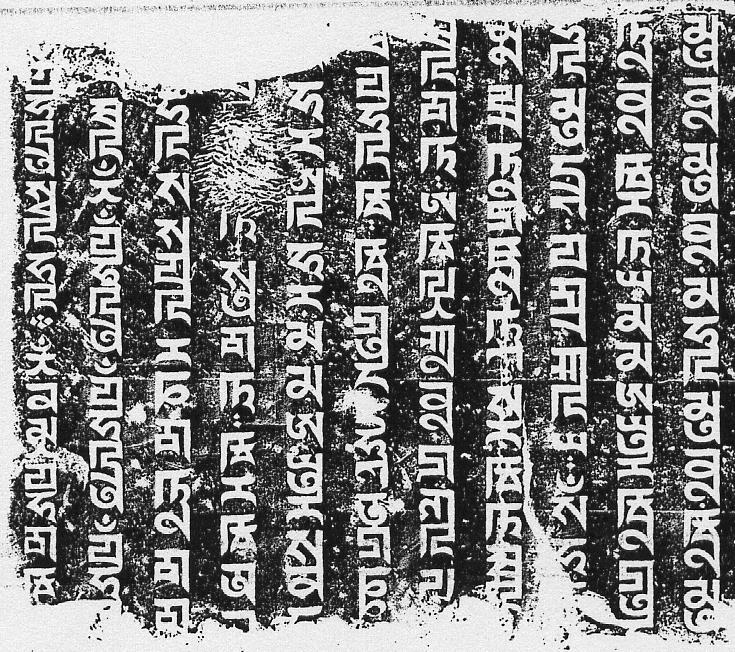
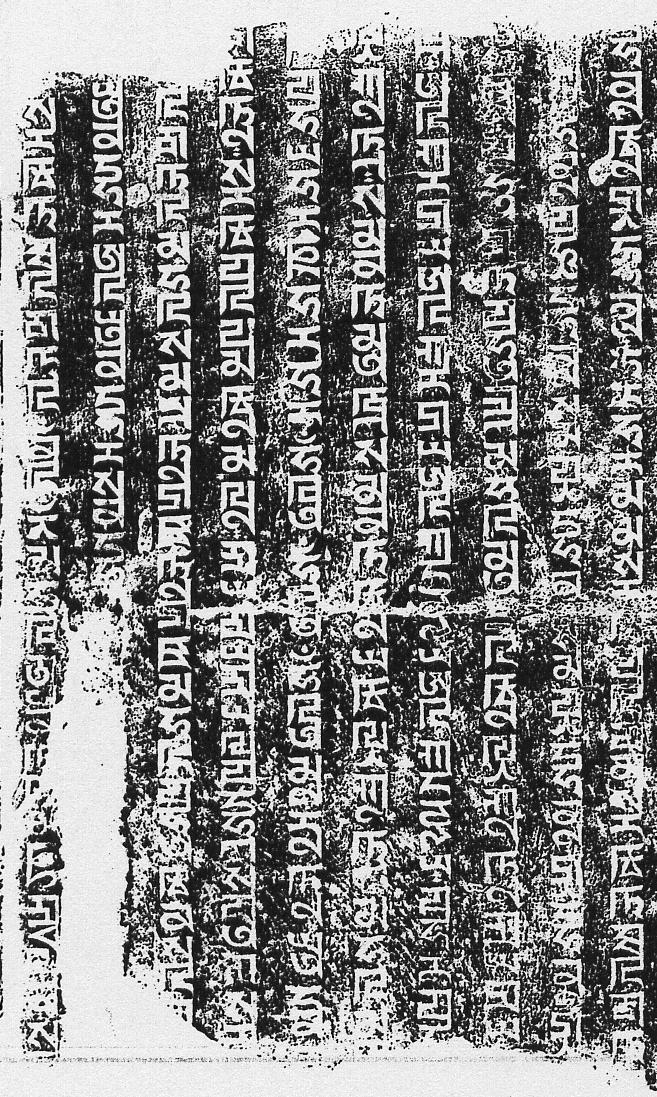
The 'Phags-pa transliteration of the Sanskrit texts Uṣṇīṣavijaya-dhāraṇī and Tathāgatahṛdaya-dhāraṇī at Juyong Guan include the following reversed letters :
Tibetan also has a reversed letter SHA (U+0F65 : TIBETAN LETTER SSA ཥ) that is used to represent the Sanskrit retroflex letter ṣ, but no corresponding 'Phags-pa letter is found in the Juyong Guan inscriptions. Where the Tibetan version of the Uṣṇīṣavijaya-dhāraṇī and Tathāgatahṛdaya-dhāraṇī at Juyong Guan has a reversed letter SHA, the 'Phags-pa text uses an ordinary unreversed letter SHA. For example, Tibetan ā-kar-ṣaya ཨཱ་ཀར་ཥཡ། for Sanskrit ākarṣaya corresponds to 'Phags-pa '-a kar sha ya [Tathāgatahṛdaya-dhāraṇī Line 1]; and Tibetan kṣu-ṇu ཀྵུ་ཎུ་ for Sanskrit kṣuṇu corresponds to 'Phags-pa kshu nnu [Tathāgatahṛdaya-dhāraṇī Line 2]. The reason why there is no 'Phags-pa reversed letter SHA is presumably because a reversed letter SHA would be graphically identical to the existing letter -A.
Of the nine reversed 'Phags-pa letters found in the Juyong Guan inscriptions, only the letters TTA, TTHA, DDA and NNA can be considered to be separate characters. The other five letters (reversed letters HA, I, U, E and Subjoined Y) only occur following TTA, TTHA, DDA and NNA, and can be considered as contextual variants of the unreversed letters HA, I, U, E and Subjoined Y.
The subjoined letter R is a modified form of the letter RA, corresponding to Tibetan Subjoined Letter RA ྲ, that may only occur attached to a base consonant. The letter functions like the subjoined letters Y and W, in that it modifies the phonetic value of the base consonant to which it is attached.
This letter is found in the Uṣṇīṣavijaya-dhāraṇī and Tathāgatahṛdaya-dhāraṇī inscriptions at Juyong Guan, as well as in Tibetan 'Phags-pa texts (see Illustration 5).
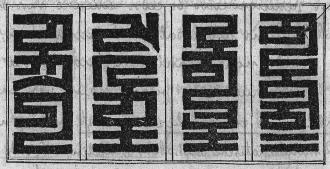
Source : Лекціи по исторіи монгольской литературы page 192.
The superfixed letter R is a modified form of the letter RA, corresponding to the T-shaped superfixed form of the Tibetan letter RA that is attached above a base consonant (other than the letter NYA, which takes the unmodified form of the letter RA). Tibetan has three superfixed letters, RA, LA and SA, but only the letter RA is written in a modified form when occuring in a superfixed position. When writing Tibetan with the 'Phags-pa script the superfixed letters LA and SA are written with the ordinary forms of these letters, whilst the superfixed letter R is written with the modified T-shaped letter R, which ligates with the base consonant that follows it (presumably superfixed R before the letter NYA would be written with an ordinary letter RA, but I have yet to see any such example).
The superfixed letter R occurs in a couple of Yuan dynasty seals, such as the Seal of the Imperial Preceptor Sangs-rgyas-dpal (see Illustration 6) and the Seal of the Sakya Lamas.

Source : Minzu Yuwen 民族語文 1997.3 Back Cover Illustration XI.
The 'Phags-pa Candrabindu sign is used to represent both the Candrabindu and the Anusvara signs in Sanskrit and Tibetan. In modern Devanagari usage the Candrabindu is used to represent the nasalisation of the vowel it is attached to, whereas the Anusvara is used to represent a nasal consonant that is homorganic with the following sound, although in traditional Sanskrit texts this convention may not be adhered to, and the Candrabindu and Anusvara may be used interchangeably. In Tibetan the Anusvara [U+0F7E] is normally used for both Sanskrit Candrabindu and Anusvara, and the Tibetan Candrabindu sign [U+0F83] is less frequently encountered (however, in the Tibetan version of the Uṣṇīṣavijaya-dhāraṇī and Tathāgatahṛdaya-dhāraṇī inscriptions at Juyong Guan the Candrabindu is used exclusively).
Many examples of the 'Phags-pa Candrabindu sign are found in the Uṣṇīṣavijaya-dhāraṇī and Tathāgatahṛdaya-dhāraṇī inscriptions at Juyong Guan (see Illustrations 3 and 4), although interestingly the Sanskrit syllable oṁ that starts the two Mongolian inscriptions engraved in small-sized 'Phags-pa script at Juyong Guan is written simply as om, with the 'Phags-pa letter MA instead of the Candrabindu.
The 'Phags-pa Candrabindu sign may also be found on 'Phags-pa inscriptions on Yuan porcelain, as well as on Yuan dynasty Official Passes (see for example Illustration I [科右中旗夜巡牌] on the inside back cover of Minzu Yuwen 民族语文 1995.3).
The 'Phags-pa Candrabindu is different from all other 'Phags-pa letters, in that it is always written on top of the first letter of the word, even though it is pronounced as the final sound of the word. Thus in the 'Phags-pa word bh-ru^ for Sankrit bhrūṁ (see Illustration 3 Line 2), the Candrabindu (transcribed as ^) is written above the first letter of the word (BA).
The additional 'Phags-pa letters discussed above are summarised in Table 8 below :
| Number | Letter | Derivation | Letter Name | Transcription | Sanskrit or Tibetan Examples |
|---|---|---|---|---|---|
| 42. | ꡩ | TIBETAN LETTER TTA ཊ [U+0F4A] | TTA | tt | sha tt-a pa ... i ta (Sanskrit ṣaṭ pāramitā) [Ill.3 Line 6] |
| 43. | ꡪ | TIBETAN LETTER TTHA ཋ [U+0F4B] | TTHA | tth | pra tish tthi te (Sanskrit pratiṣṭhite) [Ill.3 Line 8] (TTHA plus unreversed I) dhish tthi te (Sanskrit dhiṣṭhite) [Tathāgatahṛdaya-dhāraṇī Line 16] (TTHA plus reversed I) nish tthe (Sanskrit niṣṭhe) [Tathāgatahṛdaya-dhāraṇī Line 10] (TTHA plus reversed E) |
| 44. | ꡫ | TIBETAN LETTER DDA ཌ [U+0F4C] | DDA | dd | dann dde (Sanskrit daṇḍaya) [Tathāgatahṛdaya-dhāraṇī Line 14] '-a kad ddha ya (Sanskrit ākaḍḍhaya) [Ill.4 Line 7] (DDA plus reversed HA) |
| 45. | ꡬ | TIBETAN LETTER NNA ཎ [U+0F4E] | NNA | nn | sb-a ra nna (Sanskrit spharaṇa) [Ill.3 Line 3] ush nni ... (Sanskrit uṣṇīṣa) [Ill.3 Line 6] (NNA plus reversed I) kshu nnu (Sanskrit kṣuṇu) [Tathāgatahṛdaya-dhāraṇī Line 2] (NNA plus reversed U) ha ra nne (Sanskrit haraṇe) [Ill.4 Line 5] (NNA plus reversed E) pu nn.ya (Sanskrit puṇya) [Tathāgatahṛdaya-dhāraṇī Line 13] (NNA plus reversed subjoined Y) |
| 46. | ꡱ | TIBETAN SUBJOINED LETTER RA ྲ [U+0FB2] | Subjoined RA | r | bh-ru^ (Sanskrit bhrūṁ) [Ill.3 Line 2] mu dre (Sanskrit mudre) [Ill.3 Line 9] ba dzra (Sanskrit vajra) [Ill.3 Line 9] bkra shis (Tibetan bkra-shis "prosperity, good fortune") [Ill.5] |
| 47. | ꡲ | TIBETAN LETTER RA ར [U+0F62] | Superfixed RA | r | sangs rgyas (Tibetan sangs-rgyas "Buddha") [Ill.6] |
| 48. | ꡳ | TIBETAN SIGN SNA LDAN ྃ [U+0F83] DEVANAGARI SIGN CANDRABINDU [U+0901] | Candrabindu | ^ | o^ bh-ru^ bh-ru^ (Sanskrit oṁ bhrūṁ bhrūṁ) [Ill.3 Line 2] sa^ ha ... (Sanskrit saṁhatana) [Ill.3 Line 9] |
Most Yuan dynasty 'Phags-pa texts do not use any punctuation marks at all, but those that do borrow Chinese and/or Mongolian punctuation marks. For example the 'Phags-pa texts inscribed at Juyong Guan use the Mongolian punctuation marks ᠂ [U+1802 : MONGOLIAN COMMA], ᠃ [U+1803 : MONGOLIAN FULL STOP], and ᠅ [U+1805 : MONGOLIAN FOUR DOTS]; whereas the fragments of the printed edition of the Mongolian translation of the Subhāṣitaratnanidhi use a small circle 。 [U+3002 : IDEOGRAPHIC FULL STOP] as a punctuation mark.
Tibetan 'Phags-pa texts and seals use several modified Tibetan punctuarion marks, as shown in Table 9 below.
The head mark occurs in two graphic forms, a single-looped variant corresponding to U+0F04 ༄, and a double-looped variant corresponding to U+0F04, U+0F05 ༄༅. In many texts these two forms seem to be used interchangeably (e.g. in the seal of the 13th Dalai Lama the double-looped 'Phags-pa head mark corresponds to U+0F04 in the Tibetan text; whereas in some script primers the single-looped 'Phags-pa head mark is glossed with U+0F04, U+0F05. Although the single-looped and double-looped forms of the head marks would thus seem to be glyph variants representing scribal preference, in a couple of texts that I have seen the two forms of the head mark are used contrastively : the double-looped form at the head of the first column of text; and the single-looped form at the head of a continuation column of text (see Illustration 8).
Contemporary Tibetan 'Phags-pa calligraphy often shows the use of "decorative fillers" of various shapes and sizes, which are used to fill the bottom of a column to make it the same length as the other columns on the page. For example, Illustration 9 shows decorative fillers at the bottom of columns 2, 3, 4, 7, 8 and 9 of a page of contempory 'Phags-pa calligraphy.
| Number | Letter | Derivation | Letter Name | Transcription | Usage |
|---|---|---|---|---|---|
| 49. | ꡴ | TIBETAN MARK INITIAL YIG MGO MDUN MA [U+0F04] | Single Head Mark | @ | Used to indicate the start of a text (see Illustrations 8 and 9) |
| 50. | ꡵ | Ligature of TIBETAN MARK INITIAL YIG MGO MDUN MA [U+0F04] and TIBETAN MARK CLOSING YIG MGO SGAB MA [U+0F05] ༄༅ Also equivalent to the 3rd variant form of the Mongolian Birga [U+1800] ᠀᠍) | Double Head Mark | @@ | Used to indicate the start of a text (see Illustrations 7 and 8) |
| 51. | ꡶ | TIBETAN MARK SHAD ། [U+0F0D] | Shad | / | Used to mark the end of a clause or sentence (see Illustrations 6 and 7) |
| 52. | ꡷ | TIBETAN MARK NYIS SHAD ༎ [U+0F0E] | Double Shad | // | Used to mark the end of a paragraph or line of verse (see Illustrations 5 and 7) |
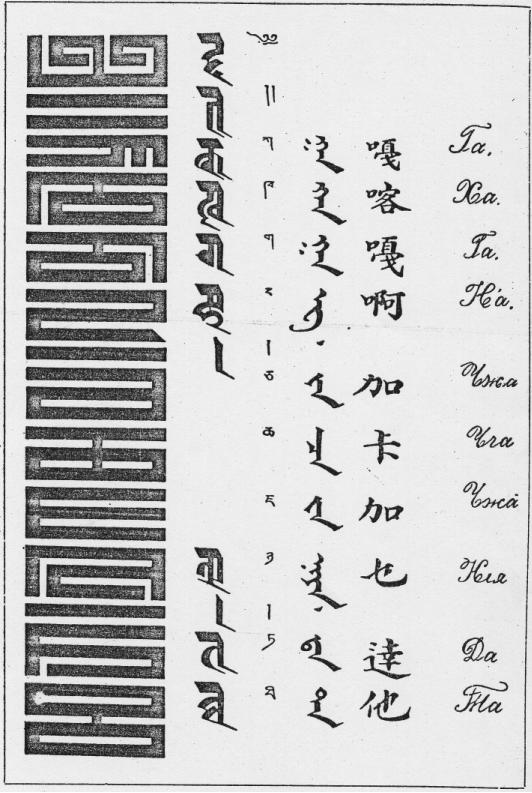
Source : The Mongolian Monuments in ḤP'AGS-PA Script page 16.
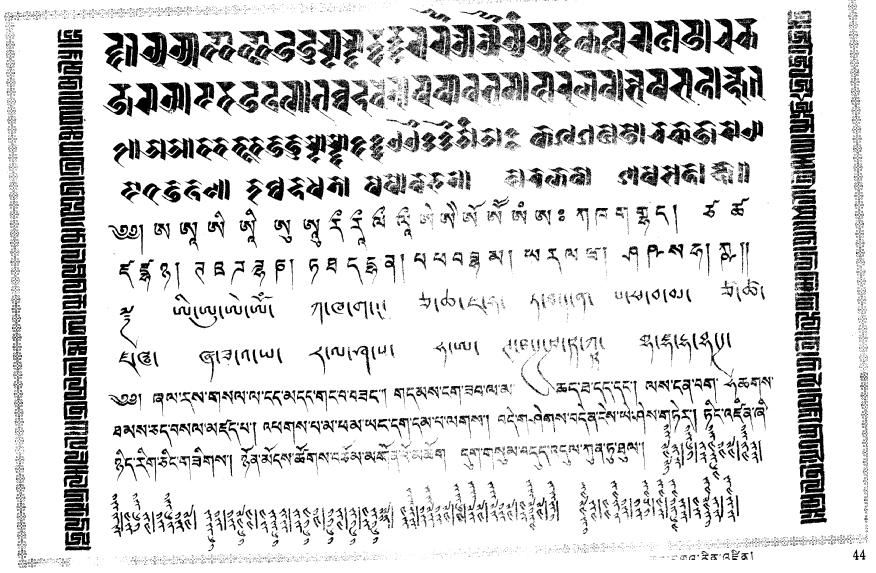
Source : Bod-kyi Yi-ge'i gZugs Ris བོད་ཀྱི་ཡི་གེའི་གཟུགས་རིས (Lhasa : Tibet People's Publishing House, 1999) page 44 [from a scan kindly provided by Chris Fynn].
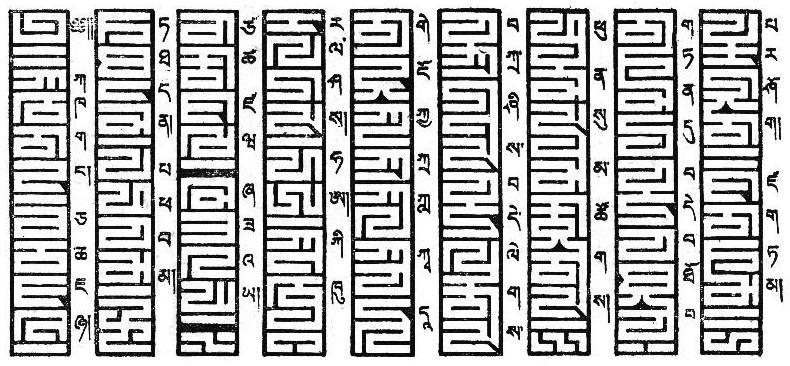
Source : Gangs-can mKhas-pa'i Phyag-bris sNa-tshogs Phyogs-bsdus Rin-chen Phreng-ba གངས་ཅན་མཁས་པའི་ཕྱག་བྲིས་སྣ་ཚོགས་ཕྱོགས་བསྡུས་རིན་ཆེན་ཕྲེང་བ (Lanzhou : Gansu People's Publishing House, 1990) p.170 [from a scan kindly provided by Chris Fynn].
Date: 2006-12-21
Forty-One Letters | Old Uighur Script | Baijiaxing Mengguwen | Menggu Ziyun